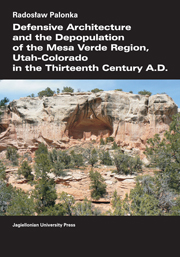Book contents
- Frontmatter
- Dedication
- Contents
- List of Figures
- Acknowledgments
- CHAPTER I Introduction
- CHAPTER II Mesa Verde region – definition, natural environment, history and methodology of research
- CHAPTER III Defining and interpreting defensive architecture
- CHAPTER IV Ethnography, ethnohistory, and Native American oral traditions concerning defensive architecture and conflicts in the Southwest
- CHAPTER V Analysis of the central Mesa Verde region architecture in the thirteenth century A.D.
- CHAPTER VI Summary and conclusions
- REFERENCES
- PHOTOGRAPHS
CHAPTER IV - Ethnography, ethnohistory, and Native American oral traditions concerning defensive architecture and conflicts in the Southwest
Published online by Cambridge University Press: 05 September 2014
- Frontmatter
- Dedication
- Contents
- List of Figures
- Acknowledgments
- CHAPTER I Introduction
- CHAPTER II Mesa Verde region – definition, natural environment, history and methodology of research
- CHAPTER III Defining and interpreting defensive architecture
- CHAPTER IV Ethnography, ethnohistory, and Native American oral traditions concerning defensive architecture and conflicts in the Southwest
- CHAPTER V Analysis of the central Mesa Verde region architecture in the thirteenth century A.D.
- CHAPTER VI Summary and conclusions
- REFERENCES
- PHOTOGRAPHS
Summary
Archaeology, as the study of a past rarely preserved in written form, faces a very difficult task. Having often only ‘mute’ artifacts at its disposal, archaeology can never reconstruct a particular culture in its entirety. Moreover, it is not always clear which artifacts are indicators of membership in a particular linguistic, religious, ethnic, or social group or how to select those artifacts from the full assemblage (Renfrew and Bahn 2002). Detailed analysis of the material culture left by humans, and accurate reconstruction of societies requires archaeologists to incorporate the work and research results of other disciplines. Thus, it may require cooperation and a multidisciplinary or interdisciplinary approach more than other fields of study.
Southwestern archaeology, including the archaeology of the Mesa Verde region, owes much of its successful progress to its collaboration with researchers in other scientific disciplines, for example, history, cultural anthropology, sociology, linguistics, environmental studies, and dendrochronology, as well as other sciences, and even mathematics and computer sciences (computer modeling of ancient societies) in recent times. Ethnohistoric and ethnographic data, as well as oral traditions of contemporary American Indians, are also very useful to the archaeology of the Southwest. Even though such records usually refer to historic and more recent times, they may help us understand what happened near the end of the thirteenth century A.D. in the Mesa Verde region. Using oral tradition and ethnographic and ethnohistoric records to supplement archaeological data can lead to more comprehensive archaeological views and theories (e.g., Brumfiel 2003).
- Type
- Chapter
- Information
- Defensive Architecture and the Depopulation of the Mesa Verde Region, Utah-Colorado in the Thirteenth Century AD , pp. 57 - 74Publisher: Jagiellonian University PressPrint publication year: 2011



